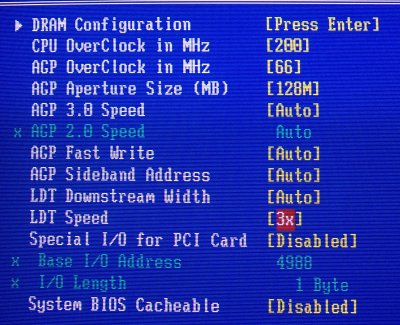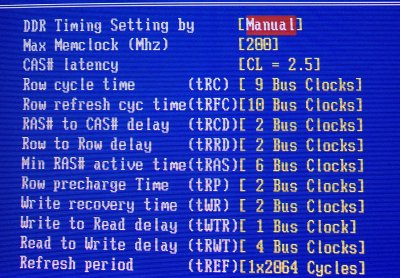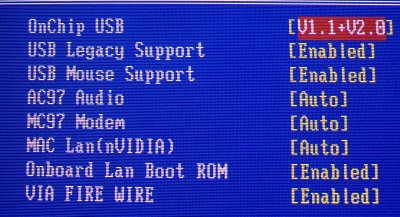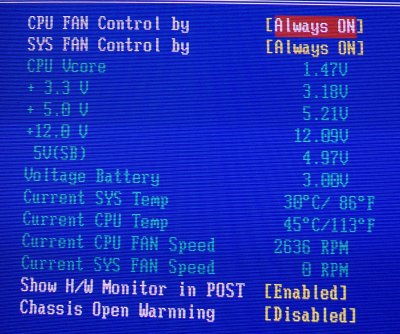K8NHA-M BIOS
Up until now, boards based on the nForce3 150 have had BIOSes that are locked in key performance areas, especially with respect to memory timings. The sensitive DRAM controller doesn't take too kindly to having memory latencies changed manually, apparently. We're skipping straight the DRAM section. The voltage section is pretty sparse. Users have the ability to raise (not lower) Vcore to 1.7%, 3.4% and 5.1% above default. While percentages are as accurate a way of defining increases in voltage as any other format, we feel that the standard 1.5v, 1.6v and 1.7v is a more intuitive method. DDR voltage, though, can be raised to a reasonable 2.9v.
The Athlon 64's architecture is such that DRAM frequencies are a divisor of overall clock speed. That's because the on-die memory controller, due to its location, runs at full core speed. The CPU clock is multiplied by 10 to arrive at the final figure, and Biostar offers frequencies between 200 - 250MHz in 1MHz increments. It's not clear whether each and every Athlon 64 3200+ is a multiplier-locked CPU. The ASUS K8V, for example, has the ability to change the multiplier factor from within BIOS. There was no ability to change the factor from the default 10 here. It's good to see explicit mention of AGP speeds, which can be altered from 66MHz - 100MHz, but there's no mention made of the sensitive PCI bus. SATA is excluded altogether; it's not carried on this model.
The LDT (Lightning Data Transport), or HyperTransport as it is presently known, is the bi-directional interconnect that links the nForce3 150 to the CPU. The link can be set to up to 4x, which translates into a speed of 800MHz. However, with an 8-bit bus width (upstream) the maximum speed between chipset and CPU is considerably less than VIA's 6.4GB/s. Setting it to 4x resulted in the board deciding not to boot at all. A moot feature.

What we've hankered for since the inception of the Athlon 64 CPU; flexible memory timings. DDR frequencies are a divisor of the CPU clock, so a divisor is necessary to support running of DDR400, DDR333 and DDR266 memory. You may not get exactly the frequency you're after, it all depends upon the closest (and lower than) the divisor can get to the maximum memory clock. We chose to run with a 200MHz memory clock (DDR400, /10 divisor). A couple of points were noted during testing. The board refused to adopt a CAS latency of 2 clocks at any speed, but it would run tRAS at a 2T setting. We used the above settings for benchmarking. It'll take users a while to fine-tune the BIOS.

There's a reasonable amount of feature integration. We'd trade in one or two of the lesser features for SATA support, however.

The hardware monitoring section isn't as comprehensive as we'd like it to be. There's no mention of DDR voltage. The CPU temperature seemed accurate considering a Zalman 7000Cu cooler was used. The Athlon 64 runs cool. That has to be one of its strengths. Incidentally, the fans can be tuned to SMART mode, presumably to quieten the system down when not under prolonged load. Our testing indicated that SMART mode made little or no difference.
A reasonable BIOS. We'd like greater control over voltages and a more comprehensive monitoring section.









